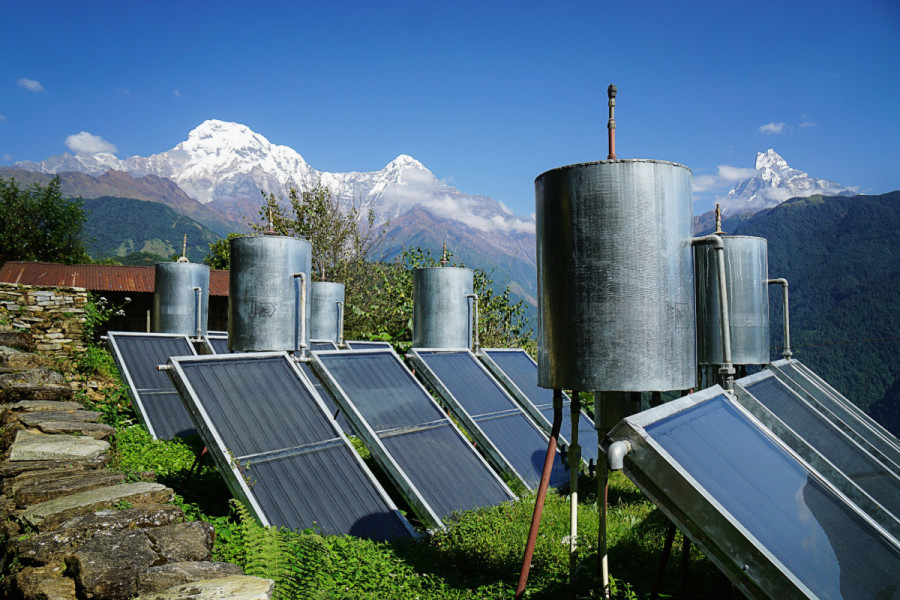Columns
Harnessing Nepal’s indigenous energy sources
Electrification must be promoted across all economic sectors to reduce reliance on imported fuels.
Nischal Dhungel & Aabhusan Khadka
A country’s population and economic conditions fundamentally shape its electricity demand; the chosen development path, whether low-carbon or high-growth, significantly influences consumption patterns. Nepal faced a substantial electricity deficit in 2015, with an actual installed capacity requirement of 1,721 megawatts (MW), while the available installed capacity was a mere 800 MW, resulting in load shedding. As per the Government of Nepal Electricity Demand Forecast Report (2015-40), even if Nepal maintains its historical GDP growth rate of 4.5 percent, it will require an installed capacity of approximately 15,000 MW to meet its growing demand by 2030. Demand is expected to surge to 82,000 gigawatt hours (GWh) by 2040, necessitating an installed capacity of over 35,000 MW. With similar policy interventions alongside a GDP growth rate of 9.2 percent, the installed capacity requirement is projected to reach 18,000 MW by 2025 and exceed 50,000 MW by 2040. As of March 2023, the total installed capacity, including generation from Nepal Electricity Authority, alternative energy promotion centre and independent power producing companies, is 2,577 MW of electricity.
The national energy consumption predominantly consisted of traditional, imported/commercial and renewable sources, accounting for 68, 29 and 6 percent of the total consumption, respectively. Traditional energy resources encompass all forms of biomass traditionally utilised for energy production. Commercial energy refers to energy sources with firmly established market values, including coal, hydropower (excluding micro-hydro) and petroleum products. Alternative or renewable energy, on the other hand, consists of indigenous renewable energy resources such as biogas, micro-hydro, solar and wind energy. The primary sectors that consume the most energy are residential, commercial, industrial, transportation, agriculture and construction and mining.
Energy indicators
Final energy intensity serves as a measure of energy consumption and efficiency levels. Energy intensity increased to 21.92 Gigajoule (GJ) per capita in 2021, up from 15 GJ per capita in 2009, signalling an increase in energy usage [One GJ is equal to 277.8 kilowatt hours (kWh)]. However, a nuanced view considering the specific energies used and their respective sectors is essential. The residential sector leads in consumption, demonstrating a growing demand for commercial fuels, albeit with sustained substantial use of traditional biomass. However, energy intensity within the residential sector has declined over the past decade, dropping from roughly 14 GJ per capita to 13.2 GJ per capita in 2019. This decrease illustrates the effects of broader access to modern energy and the infiltration of clean energy technologies.
Furthermore, the rising trend of per-household residential electricity usage signals a gradual transition towards cleaner energy facilitated by adopting more efficient electrical technologies. This can be credited to the government’s initiatives, pushing for increased electrification in economic sectors that consume electricity. As per Nepal’s second Nationally Determined Contribution (NDC) to the United Nations Framework Convention on Climate Change, mainly two economic sectors—the residential cooking sector and the transportation sector through e-vehicles—have been focused on electrification. The targets are to ensure that 25 percent of households use electricity as their primary cooking method, and the sales of 25 percent of all private passenger vehicles and 20 percent of all four-wheeler public passenger vehicles by 2025 in the transportation sector.
While Nepal is rich in indigenous resources, including traditional biomass and modern renewable sources such as solar, wind, biogas and micro-hydropower plants, a significant portion remains untapped. The import of commercial energy sources meets the country’s growing energy demand, which has been escalating at 2 percent annually, exerting considerable pressure on the national economy. Fostering electrification across all economic sectors to alleviate the reliance on imported fuels, especially petroleum products, is necessary.
Even with a surge in electricity consumption—increasing by 15 percent over recent years—its contribution to the national energy portfolio remains below 5 percent. Moreover, Nepal currently boasts the lowest per capita electricity consumption in South Asia, at 325 kWh. However, the government has set an ambitious target of increasing this figure to 700 kWh by 2024, along with a plan to transition from gasoline-powered to electric vehicles by 2031.
Long term strategy
Active plans and targets have been set to improve and electrify various economic sectors of the country. Apart from the second NDC, Nepal made a Long-Term Strategy for Net Zero Emissions in 2021 with more ambitious electrification targets. The strategy also includes electrification plans for the industrial sector through electrification of technology in process heating, motive powers and boilers usage and from commercial sectors’ complete electrification by 2045. If realised, these commitments can help Nepal increase domestic electricity consumption and simultaneously improve economic sector outputs, as studies reveal that increased consumption of energy correlates to increased economic growth.
Nepal’s track record in achieving its targets has been poor. As per the targets mentioned in the first NDC, Nepal barely accomplished what it intended to achieve by 2020, as only 0.75 percent of the country’s total vehicles were electric, as compared to the target of 20 percent. Regarding renewable energy generation, only 3.2 percent of the total energy was produced from an estimated target of 20 percent by 2020.
The United Nations Secretary-General António Guterres emphasised the urgency of addressing climate change during his visit to the Everest region. Despite Nepal's commitments at international forums like the UN Climate Change Conference to implement measures for climate adaptation and renewable energy adoption, actual progress on the ground is slow. With COP28 just around the corner, Nepal should present concrete plans and actions to mitigate climate change effects and work towards the global target of limiting temperature rise to 1.5 degrees Celsius. This includes a significant shift towards renewable energy to reduce reliance on fossil fuels, thus contributing to reduced emissions and a sustainable future.
Lastly, to meet Nepal's future electricity demand and the projected increase in consumption to utilise the indigenous green energy generated within the country, a resolute political commitment to substantial infrastructural and financial investments with effective implementation is imperative.




 10.12°C Kathmandu
10.12°C Kathmandu
















